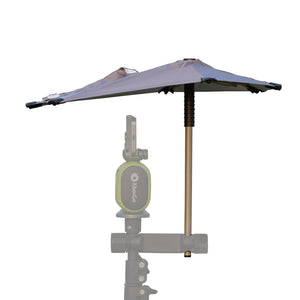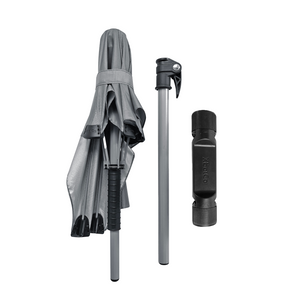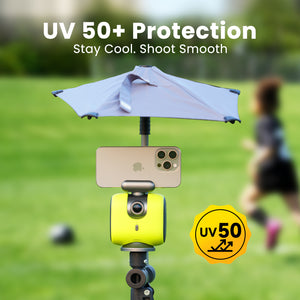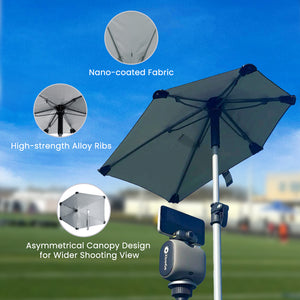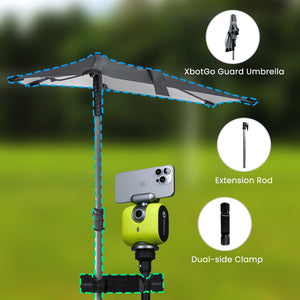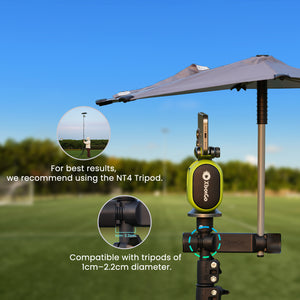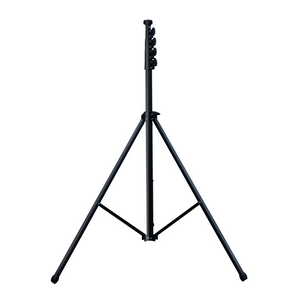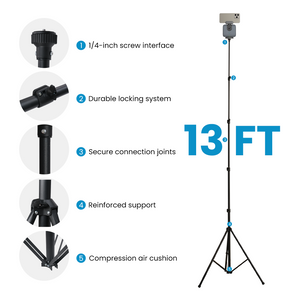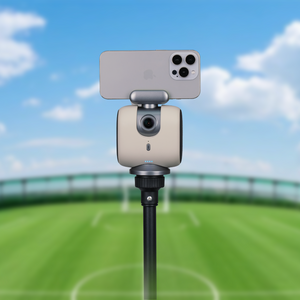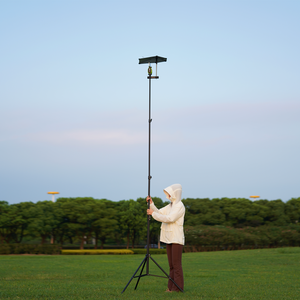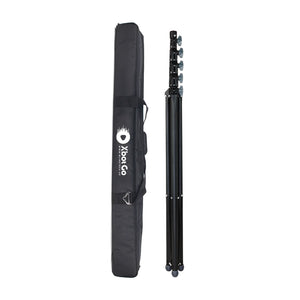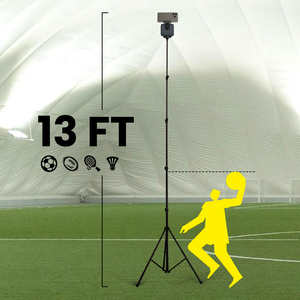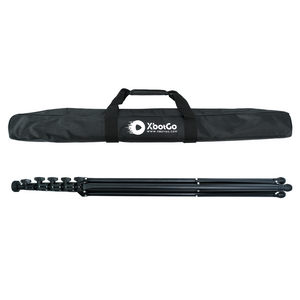XbotGo Chameleon AI Sports Camera
Dimensiones del campo de fútbol: datos clave, reglas y tácticas
Si alguna vez te has preguntado por qué los campos de fútbol parecen variar de tamaño o te has preguntado si tu campo local cumple con los estándares oficiales, no eres el único. A diferencia de las rígidas especificaciones de un campo de fútbol americano o una cancha de baloncesto, el fútbol ofrece flexibilidad dimensional, una característica que influye profundamente en la forma en que se juega este deporte rey en todo el mundo.
Ya seas entrenador preparando campos de entrenamiento, padre o madre que se familiariza con las ligas juveniles de fútbol o un aficionado curioso que intenta comprender por qué los equipos juegan de forma diferente en casa, esta guía explica todo lo que necesitas saber sobre las dimensiones de los campos de fútbol. Desde el reglamento oficial de la FIFA hasta consejos prácticos de marcaje que pueden ahorrarte horas de preparación, exploraremos cómo el tamaño del campo influye en la estrategia y por qué esta flexibilidad se ha mantenido durante más de un siglo.
Comprensión de las regulaciones de la FIFA y los estándares internacionales
En cuanto a las dimensiones de los campos de fútbol, las Reglas de Juego de la FIFA podrían sorprenderle por su flexibilidad. En lugar de exigir medidas exactas, el organismo rector internacional ofrece rangos que se adaptan a todo tipo de terrenos, desde partidos juveniles locales hasta finales de la Copa Mundial.
Las directrices oficiales
Para el juego general, la FIFA establece que los campos de fútbol deben ser rectangulares con estas dimensiones:
Longitud (líneas de toque):
- Mínimo: 100 yardas (90 metros)
- Máximo: 130 yardas (120 metros)
Ancho (líneas de gol):
- Mínimo: 50 yardas (45 metros)
- Máximo: 100 yardas (90 metros)
Esto significa que, en teoría, un campo de fútbol podría tener entre 4.500 y 13.000 yardas cuadradas: ¡casi una diferencia de tres veces en área de juego!
Estándares internacionales de partidos
Cuando los equipos nacionales compiten o los clubes se enfrentan en torneos continentales, se aplican pautas más estrictas:
- Longitud: 110-120 yardas (100-110 metros)
- Ancho: 70-80 yardas (64-75 metros)
La mayoría de los estadios de élite rondan las dimensiones preferidas por la FIFA de 115 × 74 yardas (105 × 68 metros), que se han convertido en el estándar de oro no oficial para el fútbol profesional.
¿Por qué existe esta flexibilidad?
Las raíces de la variación dimensional se remontan a los orígenes del fútbol en la Inglaterra del siglo XIX. Como explicó un experto : «Las universidades inglesas donde se jugaba originalmente al fútbol tenían campos de diferentes tamaños. Por lo tanto, para que todos pudieran jugar, las reglas establecían una amplia gama de dimensiones».
Este enfoque práctico permitió que el deporte prosperara sin obligar a los clubes a reconstruir sus estadios. Hoy en día, esta flexibilidad cumple múltiples propósitos:
- Se adapta a diferentes niveles de juego y desarrollo físico.
- Permite que los estadios existentes alberguen fútbol sin grandes renovaciones
- Permite variaciones tácticas basadas en las fortalezas del equipo.
- Preserva lugares históricos que podrían no cumplir con las dimensiones "ideales" modernas
Dimensiones del campo de fútbol juvenil por grupo de edad
El fútbol juvenil adapta inteligentemente el tamaño de los campos a las capacidades físicas y necesidades de desarrollo de los jugadores. Estas dimensiones progresivas garantizan que los jóvenes jugadores puedan disfrutar del juego sin verse abrumados por los campos de tamaño adulto.
Menores de 6 a 8 años (formato 4v4)
En este nivel introductorio, todo está miniaturizado para promover los toques de balón y el desarrollo de habilidades básicas:
- Tamaño del campo: 25-35 yardas × 15-25 yardas
- Tamaño de la portería: 6 pies × 4 pies
- Pelota: Tamaño 3
- Estructura del juego: Cuatro cuartos de 10 minutos
- Jugadores: 4vs4 sin porteros
Estos campos diminutos, aproximadamente del tamaño de una cancha de baloncesto, mantienen a los jugadores jóvenes interesados y activos en lugar de perdidos en espacios enormes.
Menores de 9-10 años (formato 7v7)
A medida que los jugadores desarrollan resistencia y conciencia espacial, las dimensiones del campo se expanden:
- Tamaño del campo: 55-65 yardas × 35-45 yardas
- Tamaño de la portería: 18,5 pies × 6,5 pies
- Pelota: Tamaño 4
- Estructura del juego: Dos mitades de 25 minutos
- Jugadores: 7 contra 7, incluidos los porteros.
Menores de 11-12 años (formato 9 contra 9)
Esta etapa de transición une los juegos reducidos con el fútbol 11 contra 11:
- Tamaño del campo: 70-80 yardas × 45-55 yardas
- Tamaño de la portería: 21 pies × 7 pies
- Pelota: Tamaño 4
- Estructura del juego: Dos mitades de 30 minutos
- Jugadores: formato 9v9
Menores de 13 años (formato 11 contra 11)
Los adolescentes pasan a campos de tamaño adulto con duraciones de juego apropiadas para su edad:
- Tamaño del campo: 100-130 yardas × 50-100 yardas
- Tamaño de la meta: 24 pies × 8 pies (tamaño adulto completo)
- Pelota: Tamaño 5
- Estructura del juego:
- U13-14: Dos tiempos de 35 minutos
- U15-16: Dos tiempos de 40 minutos
- U17+: Dos tiempos de 45 minutos
Especificaciones de la escuela secundaria y la universidad
Fútbol de escuela secundaria (estándares de la NFHS)
La Federación Nacional de Asociaciones de Escuelas Secundarias Estatales proporciona pautas que equilibran las dimensiones adultas con consideraciones prácticas:
- Recomendado: 110 yardas × 65 yardas
- Alcance aceptable: 100-120 yardas × 55-80 yardas
- Verificación de la realidad: muchas escuelas secundarias utilizan instalaciones multideportivas, por lo que las dimensiones a menudo se inclinan hacia los requisitos mínimos.
Fútbol universitario (reglamento de la NCAA)
El fútbol universitario exige una mayor estandarización para garantizar la equidad competitiva:
- Longitud: 115-120 yardas (más estrictas que las pautas generales de la FIFA)
- Ancho: 70-75 yardas
- Tamaño típico: La mayoría de los campos de la NCAA miden cerca de 115 × 70 yardas
Como establece el reglamento de la NCAA : "El campo de juego será rectangular, cuyo ancho no será mayor de 75 yardas ni menor de 70 yardas y no excederá el largo".
Variaciones de la liga profesional y ejemplos de estadios
Los clubes profesionales eligen estratégicamente las dimensiones del campo según las directrices de la FIFA, lo que crea ventajas sutiles pero significativas para jugar en casa.
Diversidad de la Premier League
La máxima categoría del fútbol inglés muestra cómo los equipos adaptan sus campos:
- Manchester City (Etihad Stadium): 116 × 77 yardas
- Entre los más grandes de la Premier League
- Se adapta a su estilo de posesión y ataque amplio.
- West Ham United: Notablemente más estrecho que la mayoría
- Las dimensiones compactas favorecen la solidez defensiva
- Limita el espacio para los extremos rivales
- Arsenal (Emirates Stadium): 114 × 74 yardas
- Cerca de las dimensiones recomendadas por la FIFA
- Equilibrado para diversos enfoques tácticos
Estándares MLS
La Major League Soccer mantiene estándares más estrictos que muchas ligas:
- Mínimo: 110 × 70 yardas
- Tamaño común: 120 × 75 yardas
- Excepción notable: la configuración del Yankee Stadium del NYCFC utiliza el mínimo absoluto (110 × 70 yardas) debido a las limitaciones del campo de béisbol.
Una persona Quienes asistieron a los partidos del NYCFC comentaron: "He visto fútbol toda mi vida y me di cuenta de esto este año. Estaba viendo al NYCFC en casa, en el Yankee Stadium, y me preguntaba cómo podían jugar en un campo tan pequeño".
Comparaciones de sedes internacionales
- Camp Nou (Barcelona): 115 × 74 yardas - Maximiza el ancho para su estilo tiki-taka
- Santiago Bernabéu (Real Madrid): 115 × 74 yardas
- Estadio de Wembley: 115 × 75 yardas - Un poco más ancho que la mayoría
- Old Trafford (Manchester United): 116 × 76 yardas
El impacto estratégico de las dimensiones del campo
Las dimensiones del campo influyen profundamente en los enfoques tácticos, la selección de jugadores y los resultados de los partidos. Comprender estos impactos revela por qué los equipos locales disfrutan de ventajas que van más allá del apoyo del público.
Cómo el tamaño influye en el estilo de juego
Los campos más grandes favorecen:
- Equipos basados en la posesión: Más espacio para circular el balón y cansar a los oponentes
- Lados atléticos: recompensa una condición física y un ritmo superiores
- Juego de alas: El ancho adicional permite que los laterales y extremos estiren las defensas.
- Tácticas de balones largos: las distancias mayores hacen que el juego directo sea más viable
Beneficio de los campos más pequeños:
- Equipos defensivos: Menos espacio para cubrir, más fácil mantener una formación compacta.
- Jugadores técnicos: Los espacios reducidos premian el control cercano por sobre el ritmo puro
- Laterales de alta presión: las distancias más cortas hacen que la presión sea más efectiva
- Especialistas en jugadas a balón parado: Más oportunidades cerca del gol
Adaptaciones tácticas del mundo real
Los equipos manipulan activamente las dimensiones para obtener ventaja competitiva. Como se señala en nuestra investigación, el Glasgow Rangers es famoso por reducir su campo en la eliminatoria de la Copa de la UEFA 1987-88 contra el Dinamo de Kiev, conteniendo con éxito el juego expansivo del equipo ucraniano para remontar una desventaja en la ida.
Un experto en tácticas de fútbol explicó: "Un campo más grande requiere correr más y puede ser más exigente físicamente, mientras que un campo más pequeño puede estar más congestionado y requerir más agilidad y rapidez de pensamiento".
La ventaja de jugar en casa más allá de las dimensiones
Los jugadores desarrollan memoria muscular para las características únicas de su campo de juego local:
- Distancia desde la línea de banda hasta el área penal para el centro
- Ángulos óptimos para disparos desde varias posiciones
- Conciencia espacial para el posicionamiento defensivo
- Tiempo de carreras según la longitud del campo
Marcas de campo esenciales y sus dimensiones
Si bien el tamaño general del campo varía, ciertas marcas mantienen requisitos dimensionales estrictos en todos los niveles de juego.
El área de portería (área de 6 yardas)
- Dimensiones: 6 yardas desde cada poste de la portería, extendiéndose 6 yardas hacia el campo
- Tamaño total: 20 yardas × 6 yardas
- Funciones principales:
- Los saques de meta deben originarse aquí
- Protege a los porteros de los desafíos peligrosos
- Determina la ubicación del tiro libre indirecto para ciertas infracciones
El área penal (área de 18 yardas)
- Dimensiones: 18 yardas desde cada poste de la portería, extendiéndose 18 yardas hacia el campo
- Tamaño total: 44 yardas × 18 yardas
- Elementos críticos:
- Solo se permite tocar el balón por parte del portero dentro de esta zona
- Las faltas aquí resultan en tiros penales.
- Contiene el punto penal exactamente a 12 yardas del centro de la línea de gol.
Especificaciones del círculo central
- Radio: 10 yardas desde el punto central
- Propósito: Garantizar el espaciamiento adecuado en los saques iniciales.
- Uso adicional: Define la zona de exclusión durante las tandas de penaltis.
El arco de penalización
A menudo llamado "la D", este arco garantiza que todos los jugadores permanezcan a 10 yardas del punto penal durante los tiros penales. Está marcado con un radio de 10 yardas desde el punto penal, pero solo la parte exterior del área penal está pintada.
Especificaciones de las esquinas
- Radio del arco: 1 yarda desde la bandera de esquina
- Altura de la bandera: mínimo 5 pies
- Marcas opcionales: Las marcas de hash a 10 yardas del arco de esquina ayudan a los defensores a mantener la distancia legal.
Guía práctica de configuración y marcado de campos
Ya sea que sea un padre voluntario o un miembro del equipo de jardinería, marcar adecuadamente un campo de fútbol requiere planificación, las herramientas adecuadas y técnicas comprobadas.
Lista de verificación de equipo esencial
- Herramientas de medición:
- Cintas métricas de más de 300 pies (mínimo dos)
- Rueda de medición para verificación
- Hoja de medidas precalculadas
- Suministros de marcado:
- Pintura para marcar campos deportivos (aerosol o a granel)
- Línea de cuerda para bordes rectos
- Palitos de pintura o varitas marcadoras
- Banderas y estacas de esquina
El proceso de configuración profesional
Paso 1: Establezca el perímetro. Comience colocando cintas métricas a lo largo de lo que serán sus líneas de banda. Para mayor precisión, utilice el método del triángulo 3-4-5 para asegurar esquinas de 90 grados perfectas.
- Mida 30 pies a lo largo de una línea
- Mida 40 pies a lo largo de la línea perpendicular
- La diagonal debe medir exactamente 50 pies.
Paso 2: Marque previamente todos los puntos clave Antes de pintar, marque estas posiciones con pequeños puntos de pintura o estacas:
- Puntos de penalti (12 yardas desde el centro de la línea de gol)
- Tiros de esquina en el área penal (18 yardas desde cada poste)
- Córners en el área de portería (a 6 yardas de cada poste)
- Puntos del radio del círculo central
- Posiciones del arco de esquina
Paso 3: Encordar y pintar. Use líneas de cuerda para todos los bordes rectos, pintando a lo largo del borde interior para mayor precisión. Para arcos:
- Fije la cinta métrica en el punto central
- Extender hasta el radio adecuado
- Camine lentamente manteniendo la tensión.
- Mantenga la barra de pintura en posición vertical para lograr líneas limpias
Consejos profesionales para ahorrar tiempo
Dibujo de marcadores de campo experimentados:
- Cree una Hoja Maestra de Medidas: Calcule con antelación todas las distancias para el tamaño específico de su campo. Incluya mediciones de varios puntos de referencia.
- Utilice puntos de referencia naturales: si marca el mismo campo repetidamente, tenga en cuenta las características permanentes (postes de luz, cercas) que se alinean con los puntos clave.
- Doble trabajo en equipo: una persona maneja las medidas mientras otra pinta, lo que reduce drásticamente el tiempo de preparación.
- Invierta en equipos de calidad: las cintas métricas y las herramientas de marcado de calidad profesional se amortizan con el tiempo ahorrado y la precisión obtenida.
Para los equipos que buscan analizar cómo las diferentes dimensiones del campo afectan su juego, la tecnología moderna ofrece soluciones innovadoras. El sistema de cámara deportiva con IA XbotGo Chameleon ajusta automáticamente sus algoritmos de seguimiento a diferentes tamaños de campo, lo que garantiza que los entrenadores capturen imágenes de calidad, ya sea que trabajen en campos reglamentarios o en campos juveniles compactos. Esta adaptabilidad ayuda a los equipos a estudiar cómo se aplican sus tácticas en diferentes superficies de juego.
Errores comunes de marcado que se deben evitar
- Olvidar el ancho de línea: todas las líneas deben tener el mismo ancho y no exceder las 5 pulgadas.
- Puntos de penalti desalineados: deben estar exactamente perpendiculares a la línea de gol
- Centros de arco incorrectos: el arco de penalti se centra desde el punto de penalti, no desde la línea de gol
- Marcas asimétricas: Verifique siempre que ambas mitades coincidan exactamente
Reflexiones finales
Las dimensiones de los campos de fútbol representan más que simples medidas: encarnan la adaptabilidad y la profundidad estratégica del deporte. Desde los jóvenes jugadores que dan sus primeros toques en canchas pequeñas hasta los profesionales que ejecutan tácticas complejas en estadios impecables, estas dimensiones variables moldean cómo se juega, se ve y se entiende el fútbol.
La próxima vez que veas un partido, presta atención a cómo los equipos utilizan el espacio. Observa cómo los equipos que priorizan la posesión parecen ampliar el campo, mientras que los equipos defensivos lo comprimen. Observa cómo algunos jugadores brillan en espacios abiertos, mientras que otros sobresalen en zonas congestionadas. Estas sutilezas, influenciadas por las dimensiones del campo, añaden complejidad al deporte rey.
Ya sea que estés marcando líneas para un torneo juvenil, analizando tácticas profesionales o simplemente satisfaciendo tu curiosidad sobre por qué varían los campos de fútbol, recuerda que esta flexibilidad dimensional no es una rareza, sino una característica que ha contribuido a convertir al fútbol en el deporte más popular del mundo. Al adaptarse a las condiciones locales en lugar de exigir una conformidad rígida, el fútbol se ha abierto camino en comunidades de todo el mundo, desde estrechos espacios urbanos hasta extensos campos rurales.
Comprender las dimensiones del campo mejora la apreciación de los matices tácticos y los desafíos prácticos del fútbol. Con este conocimiento, nunca volverás a ver un campo de fútbol con los mismos ojos.
XbotGo Chameleon AI Sports Camera
Capture every moment with AI-powered tracking. Perfect for coaches, parents, and athletes who want seamless footage without manual filming.







 Soccer
Soccer Basketball
Basketball Ice Hockey
Ice Hockey Rugby
Rugby










